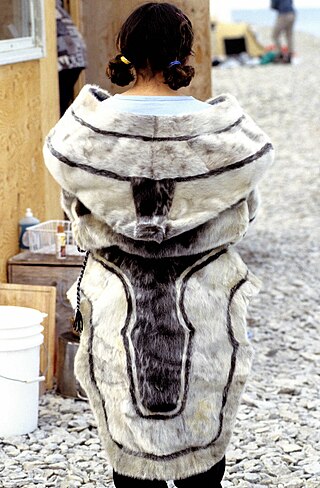
The amauti is the parka worn by Inuit women of the eastern area of Northern Canada. Up until about two years of age, the child nestles against the mother's back in the amaut, the built-in baby pouch just below the hood. The pouch is large and comfortable for the baby. The mother can bring the child from back to front for breastfeeding or for eliminatory functions without exposure to the elements. This traditional eastern Arctic Inuit parka, designed to keep the child warm and safe from frostbite, wind and cold, also helps to develop bonding between mother and child.
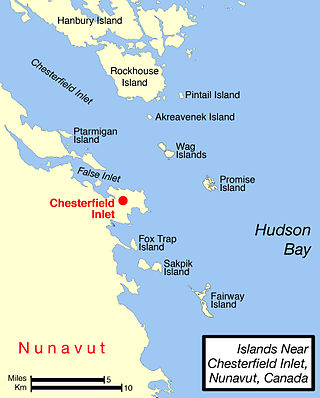
Chesterfield Inlet is an inlet in Kivalliq Region, Nunavut, Canada. It is an arm of northwestern Hudson Bay, and the end point of the Thelon River after its passage through Baker Lake. Cross Bay, a large widening of the inlet, occurs 30 kilometres (19 mi) east of Baker Lake. There are several islands located within the inlet.
The Ottawa Islands are a group of currently uninhabited islands situated in the eastern edge of Canada's Hudson Bay. The group comprises 24 small islands, located at approximately 60N 80W. The main islands include Booth Island, Bronson Island, Eddy Island, Gilmour Island, J. Gordon Island, Pattee Island, and Perley Island. The highest point is on Gilmour Island, which rises to over 1,800 ft (550 m). Located a short distance off the northwest coast of Quebec's Ungava Peninsula, they, like the other coastal islands in Hudson Bay, were historically part of the Northwest Territories, and became Crown Land upon the creation of Nunavut in 1999. Nunavik Inuit have occupied these islands since time immemorial and gained constitutionally-protected harvest and access rights under the Nunavik Inuit Land Claim Agreement signed in 2007.

Inuit dolls are made out of soapstone and bone, materials common to the people of northern Alaska, Greenland and northern Canada. Many are clothed with animal fur or skin. Their clothing articulates the traditional style of dress necessary to survive cold winters, wind, and snow. Dolls could have been gifts to young Inuit girls, to be used as teaching devices and passing down of culture. With these dolls, young girls learn various skills necessary for their survival such as skin preparation, cutting & sewing, proper use of materials, designs and significance of symbols in their cultures. Inuit dolls were enjoyed by both young and old Inuit individuals and give an excellent insight into Inuit culture.
The Ahiarmiut ᐃᓴᓪᒥᐅᑦ or Ihalmiut or are a group of inland Inuit who lived along the banks of the Kazan River, Ennadai Lake, and Little Dubawnt Lake, as well as north of Thlewiaza River, in northern Canada's Keewatin Region of the Northwest Territories, now the Kivalliq Region of present-day Nunavut.
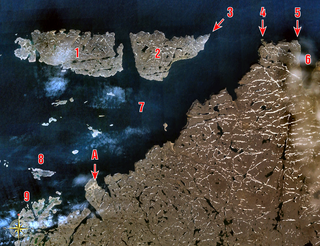
The Digges Islands are members of the Arctic Archipelago in the territory of Nunavut. The two islands, West Digges and East Digges, are located in Digges Sound, an arm of Hudson Bay, where the strong currents of the bay meet Hudson Strait.

Copper Inuit, also known as Inuinnait and Kitlinermiut, are a Canadian Inuit group who live north of the tree line, in what is now the Kitikmeot Region of Nunavut and in the Inuvialuit Settlement Region in the Inuvik Region of the Northwest Territories. Most of them historically lived in the area around Coronation Gulf, on Victoria Island, and southern Banks Island.
Native Point is a peninsula in the Kivalliq Region, Nunavut, Canada. It is located on Southampton Island's Bell Peninsula at the mouth of Native Bay. It is notable for being the location of an abandoned Sadlermiut settlement, currently an archaeological site.
The Baillie Islands are located off the north coast of Cape Bathurst in the Northwest Territories, Canada. The islands formed part of the area used by the Avvaqmiut who are a branch of the Inuvialuit.
Cape Bathurst is a cape and a peninsula located on the northern coast of the Northwest Territories in Canada. Cape Bathurst is the northernmost point of mainland Northwest Territories and one of the few peninsulas in mainland North America protruding above the 70th parallel north. The first European to see the area was John Richardson, who also named it, in 1826. Some coast areas of Cape Bathurst are being eroded at a rate of 10 m (33 ft) a year.
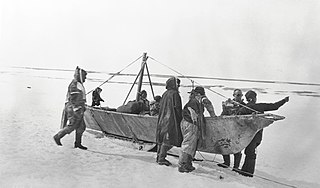
Bernard Harbour is a bay on the mainland of Nunavut, Canada. It is situated on Dolphin and Union Strait, southwest of Sutton Island.
Central Inuit are the Inuit of Northern Canada, their designation determined by geography and their tradition of snowhouses ("igloos"), fur clothing, and sled dogs. They are differentiated from Alaska's Iñupiat, Greenland's Kalaallit, and Russian Inuit. Central Inuit are subdivided into smaller groupings which include the Caribou, Netsilik, Iglulik, and Baffinland Inuit. Though Copper Inuit are geographically located in the central Arctic, they are considered to be socially and ideologically distinct from the Central Inuit.
The Avataq Cultural Institute is Nunavik's official organization for the preservation and promotion of the Inuktitut language and Inuit culture. Avataq has departments that deal with ethnography and art, as well as a library, archive and language programs.
Lucy Meeko (1929-2004) was an Inuit artist known for her multidisciplinary work in sculpture, printmaking, basketry and sewing. Meeko was born in Kuujjuaraapik, Quebec. Her career as a sculptor began in the 1950s; in the 1970s, together with her husband Noah, she created engravings for the Kuujjuarapic Cooperative.

Traditional Inuit clothing is a complex system of cold-weather garments historically made from animal hide and fur, worn by Inuit, a group of culturally related indigenous peoples inhabiting the Arctic areas of Canada, Greenland, and the United States. The basic outfit consisted of a parka, pants, mittens, inner footwear, and outer boots. The most common sources of hide were caribou, seals, and seabirds, although other animals were used when available. The production of warm, durable clothing was an essential survival skill which was passed down from women to girls, and which could take years to master. Preparation of clothing was an intensive, weeks-long process that occurred on a yearly cycle following established hunting seasons. The creation and use of skin clothing was strongly intertwined with Inuit religious beliefs.
In Inuit culture, sipiniq refers to a person who is believed to have changed their physical sex as an infant, but whose gender is typically designated as being the same as their perceived original sex. In some ways, being sipiniq can be considered a third gender. This concept is primarily attested in areas of the Canadian Arctic, such as Igloolik and Nunavik. The Netsilik Inuit used the word kipijuituq for a similar concept.

Archaeological evidence indicates that the use of Inuit clothing extends far back into prehistory, with significant evidence to indicate that its basic structure has changed little since. The clothing systems of all Arctic peoples are similar, and evidence in the form of tools and carved figurines indicates that these systems may have originated in Siberia as early as 22,000 BCE, and in northern Canada and Greenland as early as 2500 BCE. Pieces of garments found at archaeological sites, dated to approximately 1000 to 1600 CE, are very similar to garments from the 17th to mid-20th centuries, which confirms consistency in the construction of Inuit clothing over centuries.
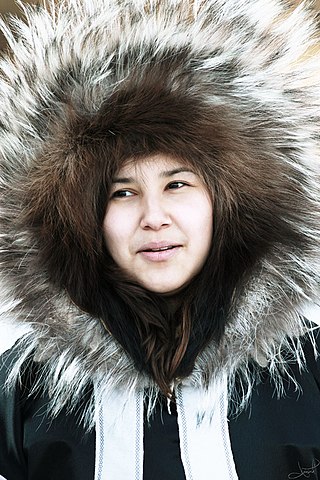
There is a long historical tradition of research on Inuit clothing across many fields. Since Europeans first made contact with the Inuit in the 16th century, documentation and research on Inuit clothing has included artistic depictions, academic writing, studies of effectiveness, and museum collections. Historically, European images of Inuit were sourced from the clothing worn by Inuit who travelled to Europe, clothing brought to museums by explorers, and from written accounts of travels to the Arctic.
Betty Kobayashi Issenman was a Canadian ethnologist. As an independent researcher, she was an expert in Inuit clothing.

Inuit navigation techniques are those navigation skills used for thousands of years by the Inuit, a group of culturally similar indigenous peoples who inhabit the Arctic and subarctic regions of Greenland, Canada, and Alaska. On the tundra, Inuit hunters would travel for long distances when hunting for game, and on the coastal waters, hunters would travel out of the sight of land, and they would need to orientate themselves to the location of favoured fishing or hunting places, or on the return journey to their dwelling place.










